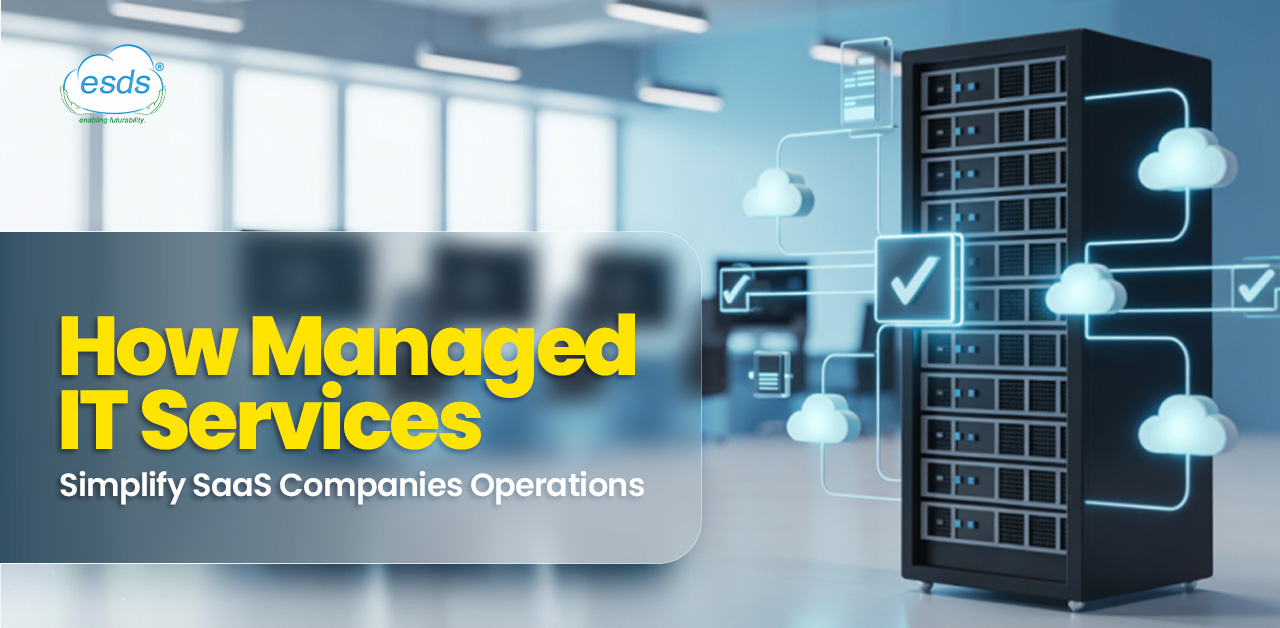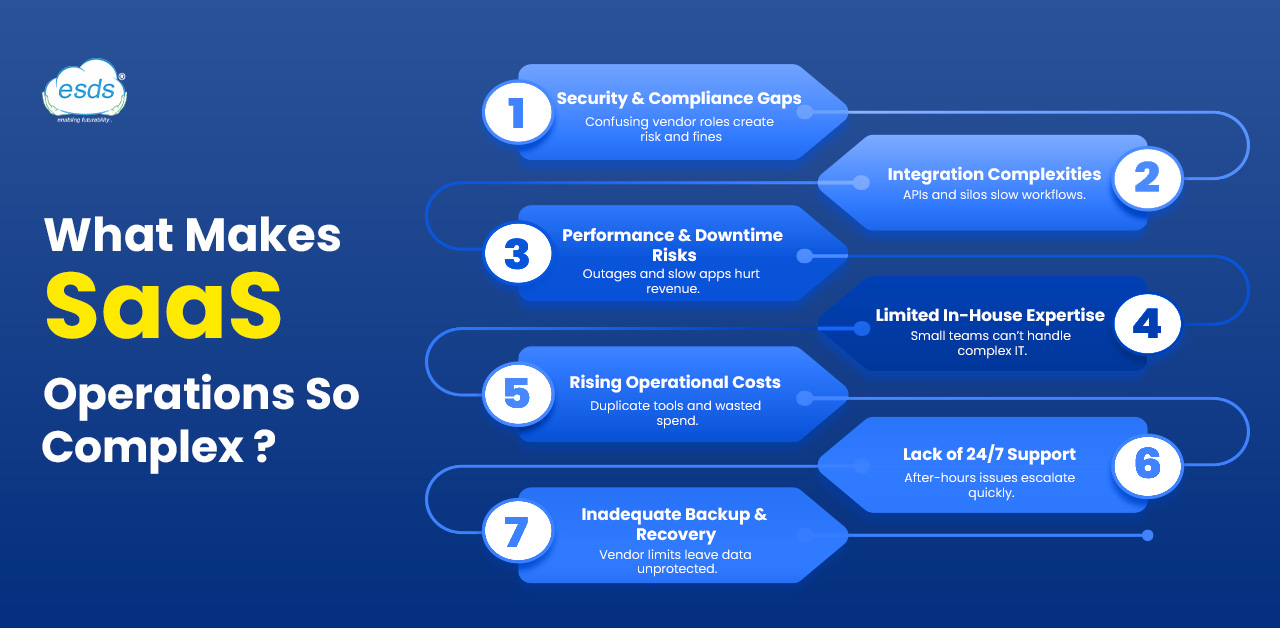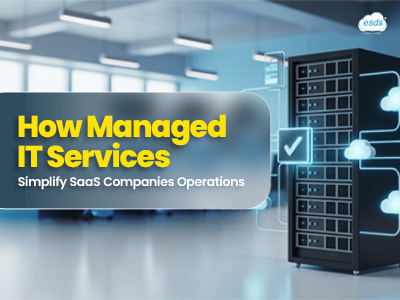Proven Ways How Managed IT Services Make SaaS Operations Stress-Free

According to a 2023 survey, 54% of data center providers (source) reported that their most significant outage cost more than $100,000, and 16% stated they lost more than $1 million. This raises concerns about how SaaS companies can prevent such devastating risks as they are rapidly growing and scaling. This is where managed IT SaaS comes into play for IT infra management in SaaS environments. Let’s explore the key approaches that managed IT services ensure reliable and smooth operation, as well as streamline SaaS management.
Why do managed IT SaaS services matter?
SaaS businesses operate in a fast-growing environment where security, uptime, and agility are prominent. However, a lack of smooth internal management of complex IT operations can put a strain on resources and hinder innovation. Gartner predicts that over the next three years, 75% of enterprises will increasingly rely on managed IT services (source) for their operations. For crucial tasks such as integration, compliance, performance monitoring, and 24/7 continuous assistance, these services provide expert surveillance.
Managed IT SaaS services ensure smooth operations while reducing risk for SaaS companies that operate multiple platforms and user environments. By 2025, it’s expected that global SaaS expenses will exceed $232 billion. (source) This may make a streamlined, secure, and scalable IT backbone more crucial than ever. That’s what managed services deliver.
What are the Key Challenges Faced by SaaS Companies?

The importance of managed IT SaaS services is undeniable. Yet, the value is best showcased by the daily operational and technical challenges that arise. SaaS companies encounter a range of setbacks every day as they develop and innovate, which can slow growth, reduce efficiency, and increase risk, often without them noticing until it’s too late.
1. Security & Compliance Gaps
SaaS businesses handle sensitive and confidential information for both private and public companies across various regions, and adhering to laws such as GDPR, HIPAA, and SOC 2 is crucial. However, most SaaS companies employ a shared responsibility model, which makes it doubtful who is responsible for protecting that data. This often leads to neglected vulnerabilities and non-compliance in the absence of specified boundaries and proactive management. This exposes businesses to data breaches, penalties, and reputational damage.
2. Integration Complexities
Integration between SaaS platforms and legacy systems becomes more complex as the number of platforms used for various business tasks increases. Operations might be delayed and workflows disrupted by inconsistent formats, data silos, and incompatible APIs. Productivity suffers when corporate procedures become disjointed and ineffective due to the absence of seamless integration.
3. Performance & Downtime Issues
It’s a continuous practice approach to maintain excellent performance and uptime amid fluctuating workloads and a global user base. SaaS solution providers often face the risk of latency challenges, slow load times, or even unexpected failures in the absence of adequate monitoring and real-time response capabilities. Every downtime moment has an immediate impact on business operations, client satisfaction, and, eventually, revenue.
4. Lack of In-House Expertise
Many SaaS businesses are product-oriented and lack in-depth technical knowledge in areas such as
- IT operations,
- security compliance, and
- cloud architecture.
Forming an in-house and fully functional internal team can be costly and time-consuming. It may often be impractical for rapidly expanding businesses. Teams are overworked and under-equipped to address crucial infrastructure issues due to this talent shortage.
5. Rising Operational Costs
Without clear visibility or control, SaaS companies often stockpile a web of tools, licenses, and cloud resources. This results in overspending, overlapping subscriptions, and expensive cloud fees if proactive administration is not accomplished. Budgets are further strained by the expense of sudden IT fixes, which makes operating costs unpredictable.
6. Non-continuous Support
SaaS customers often work 24/7, yet many businesses lack the internal resources required for constant support and monitoring. Problems that arise on weekends, holidays, or at night go unreported and escalate into severe issues. A lack of real-time responsiveness can deteriorate a consumer’s trust instantly and compromise service quality in today’s globally interconnected business world.
7. Inadequate Backup & Recovery
Customers often think their data is completely backed up. However, many SaaS vendors only offer short-term, limited data retention. As a result, this of comprehension exposes businesses to ransomware attacks, synchronization issues, and unintentional data loss, while also leaving gaps in their recovery plans. If a backup and disaster recovery plan isn’t sufficiently secure, even minor incidents can risk business continuity.
When considered separately, these challenges may seem attainable, but collectively, they create a problematic and demanding environment. This is precisely the point at which Managed IT SaaS Services provide unique value, enabling SaaS businesses to grow with greater resilience, authority, and trust.
9 key ways to simplify operations by IT infra for SaaS services
With the growth of SaaS businesses, the complexity of managing multiple platforms, users, and vendors often becomes a great operational challenge. By incorporating management strategies, managed IT SaaS services simplify the challenges by providing real-time control, security, improved performance, and more effective resource utilization. Here’s how these SaaS support services make management a more strategic and efficient function.
1. Centralised SaaS Management
It can quickly get chaotic to manage dozens of SaaS solutions with varying payment cycles, access permissions, and maintenance intervals. All SaaS apps can be monitored, controlled, and consolidated with the help of managed IT SaaS services.
- Simplified billing: Overspending gets prevented by unified tracking of subscriptions, renewals, and usage.
- Consolidated access control: Centralised provisioning and de-provisioning protect against unauthorized access.
- Unified dashboards: Provide Real-Time visibility into all platforms, making seamless management and decision-making easier.
2. Unified Monitoring and Management
Without any visibility, minor issues may gradually escalate into service disruptions. Here’s how managed IT SaaS services ensure proactive monitoring.
- Real-time monitoring: Continuous tracking of Performance, uptime, and usage metrics.
- Integrated dashboards: A single control panel is used to monitor all SaaS apps and critical infrastructure.
- Fast issue resolution: Early detection minimises end-user impacts and allows for faster remediation.
3. Automated Updates and Patch Management
Errors and delays are common when updating manually. By automating patching procedures, IT infra for SaaS reduces risk and increases stability.
- Timely security fixes: Minimise vulnerabilities by applying patches as soon as they become visible.
- Platform consistency: Automation ensures that all systems are running in the latest and secure versions.
- Maintenance with zero downtime: Updates occur without interrupting user workflows.
4. Optimised Integration and Interoperability
Workflow inefficiencies and data silos result from disconnected systems. Utilizing managed IT SaaS services facilitates the integration of your digital stack.
- Legacy integration and smooth API: Seamlessly integrates new systems with existing ones.
- Simplified signal flow: Reduces redundancy and improves accuracy.
- Increased productivity, faster collaboration, and decision making with integrated workflows.
5. Enhanced Security and Compliance
Strong security is now required due to the increased prevalence of cyber threats and heightened regulatory scrutiny. Each level of your SaaS ecosystem is protected by managed IT services.
- IAM and Data encryption: Safeguard confidential business information.
- Continuous compliance monitoring: Keeps your integrity maintained with audit-ready standards such as GDPR, HIPAA, and ISO.
- Security governance: Ensures consistent compliance through regular audits and the implementation of best practices.
6. Backup and Disaster Recovery (BaaS)
Many SaaS vendors offer limited data retention, leading to gaps in protection. IT infra for SaaS guarantees a wide range of recovery options.
- Independent backups: By backing up your data independently, you can get beyond vendor restrictions.
- Fast recovery: Restoring lost or damaged data as soon as possible reduces operational interruption.
- Business continuity: There is less downtime and greater confidence in resilience, which helps in business continuity.
7. Scalability and Resource Optimization
As your SaaS environment evolves, infrastructure must scale without causing performance bottlenecks or waste.
- Elastic resource allocation: As usage demands change, infrastructure adapts accordingly.
- Cost control: Automation and license management help prevent excessive spending.
- Scalable strategy: Systems are designed to grow without requiring a complete rebuild from scratch.
8. 24/7 Expert Support and Incident Management
In the world of SaaS, delays or outages at any time might have worldwide effects. Support from managed IT for SaaS is always available.
- 24/7 Monitoring: Even during off-hours, systems are constantly monitored.
- Fast incident response: Users experience less impact when the Mean Time to Resolution (MTTR) is accelerated.
- Working smoothly: Knowing that professionals are handling important issues allows internal teams to concentrate on strategic tasks.
9. Streamlined Vendor Management
Managing multiple SaaS providers can be hectic and time-consuming. Vendor relations are centralised under IT infra for SaaS companies.
- Single point of contact: Across all platforms, a single staff member manages support, renewals, and procurement.
- Vendor consolidation: To simplify, similar tools are found and streamlined.
- Faster resolution of issues: There is no need to switch between vendor support teams, as everything is coordinated.
Wrapping Up
Managed IT SaaS services enhance SaaS operations by employing these strategies rather than merely supporting them. These services provide SaaS businesses with the tools they need to scale more intelligently, develop more quickly, and operate with complete trust in their digital foundation, encompassing centralization, compliance, performance, and cost control.
ESDS Managed Services are specifically designed to help SaaS companies navigate this complexity. Our centralized administration platform, 24/7 expert support, security-first approach, and industry-proven track record enable SaaS providers to offer their users reliable, secure, and scalable experiences. ESDS lets you streamline IT processes so you can concentrate on what really matters: building outstanding SaaS products and improving customer service, regardless of whether you’re a startup or a business overseeing hundreds of applications.
- Achieving Secure, Reliable Compliance with India’s Data Sovereignty Mandates - November 17, 2025
- Implementing GPU workloads in critical government application - November 12, 2025
- Why Data Sovereignty Is Important for Indian Enterprises - August 22, 2025
